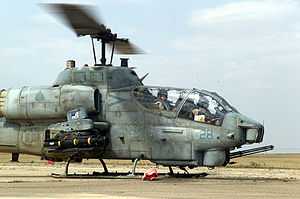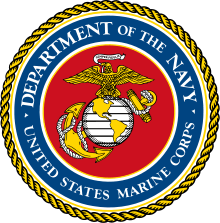HMLA-267
| Marine Light Attack Helicopter Squadron 267 | |
|---|---|
|
HMLA-267 Insignia | |
| Active |
February 15, 1944 - January 31, 1946 December 15, 1966 - present |
| Country | United States |
| Allegiance | United States of America |
| Branch | United States Marine Corps |
| Type | Light/Attack squadron |
| Role | Close Air Support |
| Part of |
Marine Aircraft Group 39 3rd Marine Aircraft Wing |
| Garrison/HQ | Marine Corps Base Camp Pendleton |
| Nickname | Stingers |
| Motto | "Anytime Anywhere" |
| Tail Code | UV |
| Engagements |
World War II * Battle of Iwo Jima Vietnam War Operation Restore Hope Operation Iraqi Freedom * 2003 invasion of Iraq *Operation Enduring Freedom |
| Commanders | |
| Current commander | LtCol Mark S. Coppess |
Marine Light Attack Helicopter Squadron 267 (HMLA-267) is a United States Marine Corps helicopter squadron consisting of AH-1Z Viper attack helicopters and UH-1Y Huey utility helicopters. The squadron is based at Marine Corps Base Camp Pendleton, California falls under the command of Marine Aircraft Group 39 (MAG-39) and the 3rd Marine Aircraft Wing (3rd MAW).
Mission
Support the Marine Air-Ground Task Force commander by providing offensive air support, utility support, armed escort and airborne supporting arms coordination, day or night under all weather conditions during expeditionary, joint or combined operations. To provide a mission capable, ready-to-deploy light utility attack helicopter squadron anytime, anywhere.
History
Origins during World War II
HMLA-267 was first activated as Marine Observation Squadron 5, VMO-5, at Marine Corps Base Quantico, Virginia, Virginia on February 15, 1944. In August 1944 came its first deployment to Marine Corps Air Station Ewa, Hawaii under the 3rd Marine Aircraft Wing to participate in the Pacific theater. The squadron saw action during the Battle of Iwo Jima, and under the 2nd Marine Aircraft Wing participated in the occupation of Japan in Sasebo from September 1945 through January 1946, at which time the squadron returned to San Diego and was deactivated on January 31, 1946.
Vietnam
With the looming Vietnam War, the subunit of Headquarters and Maintenance Squadron 30 (H&MS-30) at Marine Corps Base Camp Pendleton was redesignated as VMO-5 on December 15, 1966 becoming a full fledged training squadron. They originally fell under the command of Marine Helicopter Training Group 30 under the 3rd Marine Aircraft Wing and were equipped with a complement of UH-1E Hueys and OV-10 Broncos.[1] In March 1968, the squadron was redesignated HML-267 and remained at alert status and training replacement pilots and crew for the rest of the war. In 1971, reorganization left the squadron with only UH-1E helicopters, and by the end of 1976 only UH-1N aircraft were flown.
Post Vietnam
Every six months HML-267 rotated one-third of its assets to Marine Corps Air Station Futenma on Okinawa, Japan. The Hueys were joined by another aircraft in 1982 as the new AH-1J "Cobra"s were deployed. As part of the Unit Deployment Program (UDP) starting in 1983, HML-267 began a regular cycle of six months in Okinawa, 18 months on Camp Pendleton. During which the squadron participated in numerous training exercises including detachments to Korea, Guam, the Philippines, Hong Kong, Iwo Jima, and Australia. Redesignated HMLA-267 in 1987, the squadron received its first complement of AH-1 Cobra "SuperCobra"s. In 1988, the squadron split into three groups: A detachment on land in Okinawa, A detachment on a West Pac, and A detachment aboard the USS Dubuque.
The USS Dubuque was part of the Joint Task Force in the Persian Gulf and Operation Earnest Will. On July 3, 1988, the USS Vincennes - also a part of Operation Earnest Will - shot down an Iranian commercial Airbus A300B2-202 (Iran Air Flight 655) after mistaking it for an Iranian F-14. The total of 290 dead civilian passengers, included 66 children.
In 1990, HMLA-267 split into two groups: A detachment on land in Okinawa and another attached to HMM-164. The group attached to HMM-164 boarded the USS Okinawa on a routine West Pac deployment. The USS Okinawa eventually ended up in the Persian Gulf for Operation Desert Shield and Operation Desert Storm, spending a total of 354 days away from their home port for this deployment.
In 1992, HMLA-267 split into two groups: A detachment on land in Okinawa and another attached to HMM-164. The group attached to HMM-164 boarded the USS Tripoli on a routine West Pac. The USS Tripoli went back to the Persian Gulf for Operation Desert Sweep. The next stop for the USS Tripoli was Mogadishu, Somalia and was part of the original insertion of Marines (primarily those from HMLA-267) and the beginning of Operation Restore Hope.
Global War on Terror
In January 2003, HMLA-267 deployed aboard Amphibious Task Force West in support of Operation Iraqi Freedom. The Stingers relocated to Ali Al Salem Airbase, Kuwait February 2003 in preparation of Operation Iraqi Freedom. HMLA-267 supported the I Marine Expeditionary Force (I MEF) conducting combat operations throughout Iraq from 20 March 2003 until ordered to return to the United States in May 2003. During Operation Iraqi Freedom, the Stingers flew over 2100 combat flight hours and 1400 combat sorties in support of I MEF combat operations in just three weeks.
In June 2003, HMLA-267 participated in the Unit Deployment Program to Okinawa, Japan. During this period, the Stingers conducted exercises in South Korea, Australia and the Republic of the Philippines. From August through October 2003, the Squadron detached three UH-1N aircraft, thirteen pilots and one hundred Marines to Joint Task Force 515, in support of Operation Enduring Freedom. This detachment was selected to provide aerial escort for the President of the United States as he toured the Republic of the Philippines, the second time this HMLA has been so honored.
In October 2003, HMLA-267 was presented the John P. Giguere Award for the Marine Light Attack Helicopter Squadron of the Year for 2003.
In June 2004, a detachment of 4 AH-1W Cobras and 2 UH-1N Hueys attached to Marine Medium Helicopter Squadron 165 (REIN) on the 15th MEU. At the end of that year HMLA-267 became the sole provider of HMLA detachments to the 11th, 13th, 15th, and 31st Marine Expeditionary Units (MEU’s) in support of I MEF and III MEF. While other MAG 39 squadrons continued to deploy to Iraq in support of counter-insurgency operations there, the Stingers began regularly deploying from Southern California and Okinawa to the Western Pacific and East Asia.
In April 2010, the Squadron’s mission officially changed to support Operation Enduring Freedom (OEF).
In 2011 HMLA 267 deployed to Afghanistan in support of Operation Enduring Freedom.
As of April 2012, HMLA-267 transitioned completely from the AH-1W to the AH-1Z Viper, ending their decades long usage of the Whiskey. HMLA-267 was the first HMLA to completely transition to the AH-1Z and the UH-1Y.
HMLA-267 is currently the sole source for the 11th, 13th, and 15th MEUs with AH-1Z and UH-1Y aircraft.
Unit awards

A unit citation or commendation is an award bestowed upon an organization for the action cited. Members of the unit who participated in said actions are allowed to wear on their uniforms the awarded unit citation. HMLA-267 has been presented with the following awards:
| Ribbon | Unit Award |
| Presidential Unit Citation | |
| Navy Unit Commendation with one bronze star | |
| Meritorious Unit Commendation with three bronze stars | |
| Asiatic-Pacific Campaign Medal with one bronze star | |
| World War II Victory Medal | |
| Navy Occupation Service Medal with Asia clasp | |
| National Defense Service Medal with two Bronze Stars | |
| Iraq Campaign Medal | |
| Global War on Terrorism Expeditionary Medal | |
| Global War on Terrorism Service Medal | |
| Afghanistan Campaign Medal |
See also
- List of United States Marine Corps aircraft squadrons
- United States Marine Corps Aviation
References
- Notes
 This article incorporates public domain material from websites or documents of the United States Marine Corps.
This article incorporates public domain material from websites or documents of the United States Marine Corps.
- ↑ Fails (1978), p.147
- Bibliography
- Fails, William R. (1978). Marines and Helicopters 1962 - 1973. History & Museums Division, Headquarters Marine Corps.
- Rottman, Gordon L. (2002). U.S. Marine Corps World War II Order of Battle - Ground and Air Units in the Pacific War, 1939 - 1945. Greenwood Press. ISBN 0-313-31906-5.
- Sherrod, Robert (1952). History of Marine Corps Aviation in World War II. Washington, D.C.: Combat Forces Press.
External links
| |||||||||||||||||||||||||||||
| |||||||||||||||||||||||||||||||||
|}


